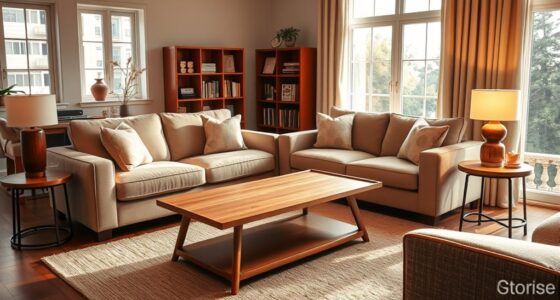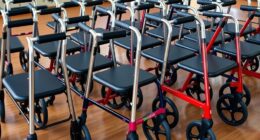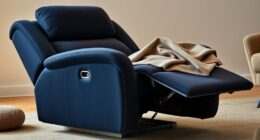To revamp your living space for enhanced elderly comfort, start by prioritizing safety and accessibility. Use universal design principles, like installing non-slip flooring, lever-style door handles, and adequate lighting. Create safe entryways with convenient landing areas and keep pathways clutter-free. Make bathrooms safer by adding grab bars and non-slip surfaces. Personalize your space with comfort-enhancing elements and soothing colors. These adjustments can make a big difference, and there's more valuable information to discover that will help you further.
Key Takeaways
- Arrange furniture to create clear pathways, minimizing obstacles and ensuring easy navigation for elderly individuals.
- Use ergonomic furniture that provides comfort and support for prolonged sitting or movement.
- Incorporate soft, warm lighting to enhance visibility and create a cozy atmosphere.
- Select non-slip mats and rugs in high-traffic areas to prevent slips and falls.
- Personalize decor with family photos and memorabilia to evoke positive memories and comfort.
Understanding Universal Design Principles for Home Modifications

When it comes to modifying your home for elderly comfort, understanding universal design principles is crucial. These principles focus on creating spaces that guarantee safety and convenience for everyone, regardless of age or ability. By incorporating features like wider doorways and lever-style handles, you can make your home more accessible, promoting aging in place. Simple changes, such as non-slip flooring, can greatly reduce accident risks and enhance overall comfort and safety. Additionally, incorporating natural elements like wood and stone can create a calming atmosphere that contributes to a sense of well-being. It's important to consider emotional support for elderly individuals during the transition to a more accessible home, as changes can be stressful.
Universal design principles prioritize equitable use and flexibility, allowing you to adapt your living space without extensive renovations. By applying these concepts, you'll create an environment that fosters independence and comfort, guaranteeing that your home remains a place where elderly occupants feel secure and at ease. Additionally, ensuring comprehensive information on home improvement can empower families to make informed decisions about modifications.
Creating Safe and Accessible Entryways
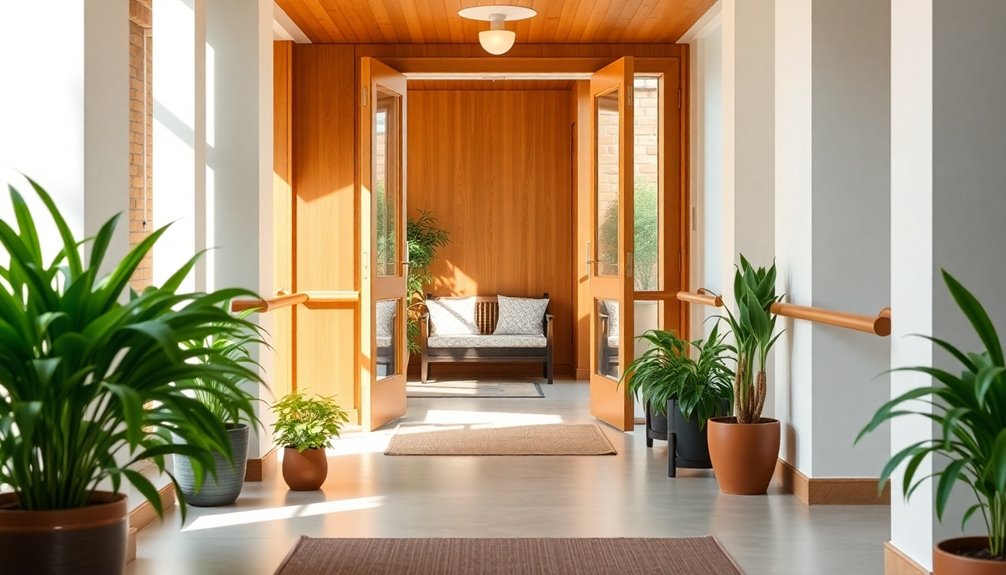
Creating safe and accessible entryways is vital for enhancing comfort and mobility. You'll want to focus on essential lighting, convenient landing spaces, and mobility-friendly design elements. Additionally, consider incorporating an air purifier to improve indoor air quality, which can lead to better health and overall comfort. Regular filter replacement is crucial for maintaining the air purifier's effectiveness, ensuring that the air remains clean and safe for everyone in the household. Furthermore, using a HEPA filter in the air purifier can significantly enhance allergen reduction in the home.
Essential Lighting Considerations
Proper lighting plays an essential role in ensuring safe and accessible entryways for elderly residents. Bright, glare-free fixtures enhance visibility and greatly reduce accident risks. Consider adding motion-sensor lights to automatically illuminate entryways at night, promoting safety. Additionally, ensuring proper airflow around the unit can help maintain a comfortable environment, especially when using air purifiers for allergen removal. Effective senior safety measures can further reduce the risk of falls and injuries in the home. Incorporating features like HEPA filtration in air purifiers can significantly improve indoor air quality, benefiting the health of elderly residents.
Here's a quick reference table for your lighting options:
| Lighting Type | Benefits | Considerations |
|---|---|---|
| Motion-sensor | Automatic illumination | Requires power source |
| LED fixtures | Energy-efficient and long-lasting | Initial installation cost |
| Pathway lights | Guides to entryways | Needs regular maintenance |
Comprehensive lighting along walkways and well-lit house numbers not only aids visibility but also helps emergency responders locate your home quickly, addressing mobility needs effectively.
Convenient Landing Spaces
Bright and well-lit entryways set the stage for safety, but adding convenient landing spaces takes accessibility to the next level.
Consider placing small tables or benches near your entryway. These convenient landing spaces provide safe surfaces for items like keys and bags, minimizing the risk of dropping belongings or losing balance. Incorporating these areas can also help promote high vibrational energy, which is essential for overall well-being. Adding a home security system can further enhance the safety of your entryway by deterring potential intruders.
Properly designed entryways enhance accessibility, making shifts easier for those with mobility challenges. By incorporating these landing areas, you can help older adults securely manage their belongings without fumbling, which reduces the likelihood of accidents.
Confirm these spaces are well-lit to improve visibility, further enhancing safety. Ultimately, convenient landing spaces promote both safety and comfort, making your home more user-friendly for aging residents. Additionally, ensuring these areas are well-lit for visibility can significantly enhance the safety of the entryway.
Mobility-Friendly Design Elements
While designing an entryway, you should prioritize mobility-friendly elements that enhance safety and accessibility for older adults.
Start by ensuring you have non-slip flooring to reduce the risk of falls. Install lever-style door handles, which are easier to use than traditional knobs, especially for those with grip challenges. Incorporating universal design principles can also help maximize comfort and usability for seniors. Additionally, ensuring good indoor air quality can contribute to a healthier living environment for elderly individuals.
Aim for zero-threshold entries to eliminate tripping hazards and create a smooth passage from outside to inside. Adequate lighting is essential; consider bright, glare-free fixtures or motion-sensor lights that activate as they approach.
Finally, regularly assess your entryway for obstacles and keep it clutter-free to maintain a safe environment. Incorporating proper disposal methods for items like toilet paper can also help prevent accidents related to clutter.
These mobility-friendly design elements will greatly improve comfort and ease of access for elderly individuals.
Installing Proper Lighting for Enhanced Safety
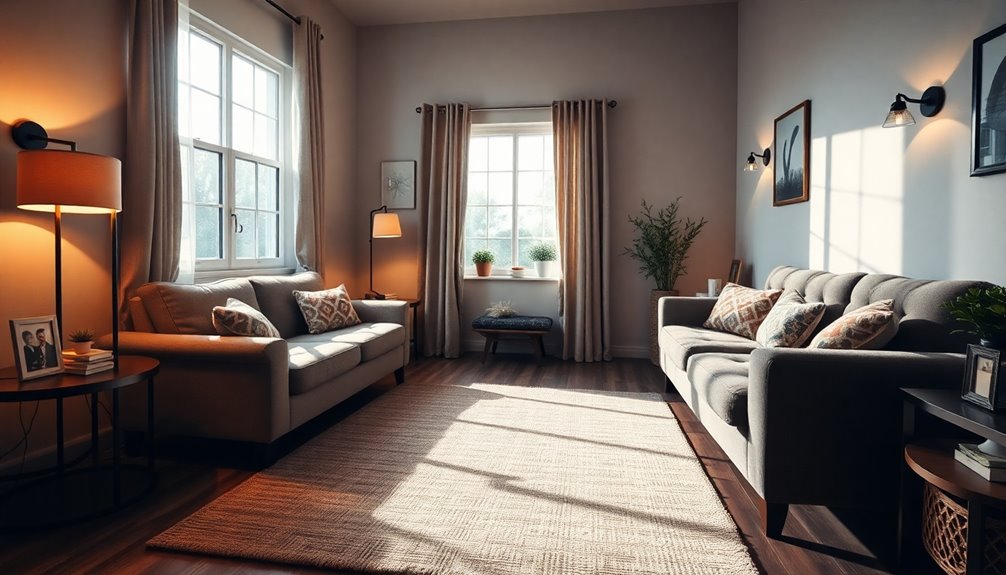
Installing proper lighting is essential for your safety at home.
Bright, glare-free fixtures and motion-sensor lights can greatly reduce fall risks by ensuring you have visibility when you need it. Additionally, understanding provincial vs. federal regulations can help you choose the best lighting solutions that meet safety standards.
Bright, Glare-Free Fixtures
Proper lighting is essential for guaranteeing safety in homes occupied by elderly residents, as it helps prevent trips and falls.
Installing bright, glare-free lighting fixtures in entryways and high-traffic areas notably reduces the risk of accidents. You should consider extensive lighting strategies that include layered options—ambient, task, and accent lighting—to accommodate various activities and enhance overall safety.
Ascertain well-placed lighting along walkways to improve visibility, clearly marking safe paths for navigation. Additionally, illuminated house numbers help emergency responders locate residences quickly during critical situations.
Motion-Sensor Lighting Benefits
Bright, glare-free lighting creates a solid foundation for safety, and adding motion-sensor lighting takes it a step further. These lights automatically turn on as you approach, ensuring visibility in critical areas like entryways and bathrooms, which helps reduce the risk of trips and falls. They're adjustable too, allowing you to customize illumination duration and movement sensitivity, enhancing safety and accessibility for everyone.
| Benefit | Description |
|---|---|
| Enhanced Safety | Illuminates areas when you need it most |
| Improved Accessibility | Supports mobility for older adults |
| Energy Efficiency | Activates only when someone is present |
Integrating motion-sensor lighting not only improves comfort but also promotes energy efficiency, making your home safer and more sustainable.
Comprehensive Illumination Strategies
When it comes to creating a safe living environment for seniors, thorough illumination strategies are key. Start by maximizing natural light in your home to enhance visibility.
Install bright, glare-free lighting fixtures in entryways and high-traffic areas to help prevent accidents. Incorporate motion-sensor lights in darker spaces, so seniors don't have to fumble for switches when finding their way.
Implement a detailed illumination plan that includes ambient, task, and accent lighting tailored to various activities. Verify house numbers and pathways are well-lit, aiding both wayfinding and emergency responders.
Adding Convenient Landing Places for Ease of Use
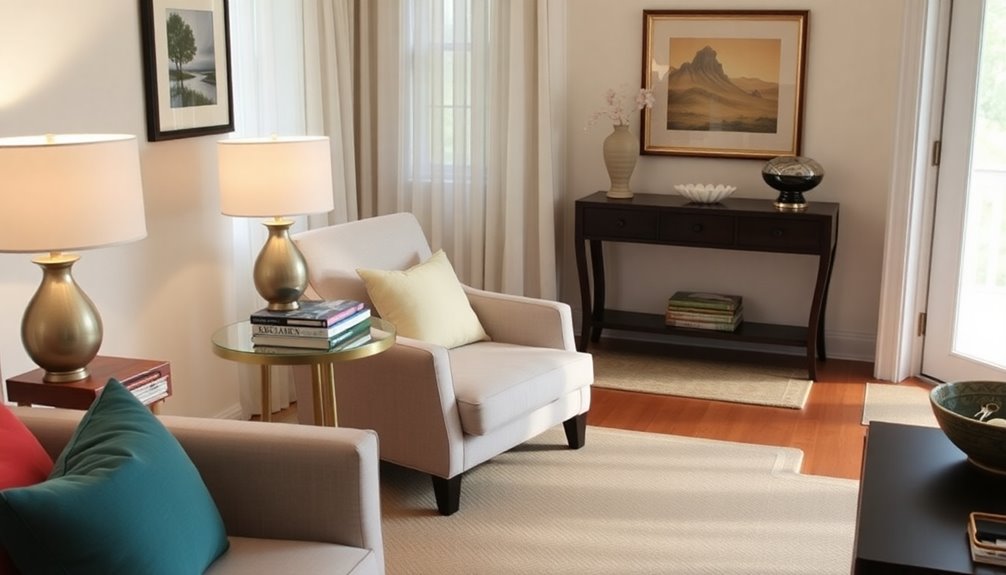
Creating convenient landing places near entryways can greatly improve ease of use for elderly residents. Small tables or benches serve as safe surfaces for placing items while entering or exiting, reducing the risk of dropping belongings or losing balance.
By providing these landing spots, you allow older adults to securely manage essentials like keys and bags, promoting a smoother shift in and out of the home. These features enhance accessibility, accommodating mobility needs for those using walkers or canes.
Properly designed landing areas contribute to a more organized environment, making it easier to navigate without unnecessary stress. Incorporating convenient landing places into your home can markedly improve functionality and comfort for aging residents.
Enhancing Mobility Throughout the Home
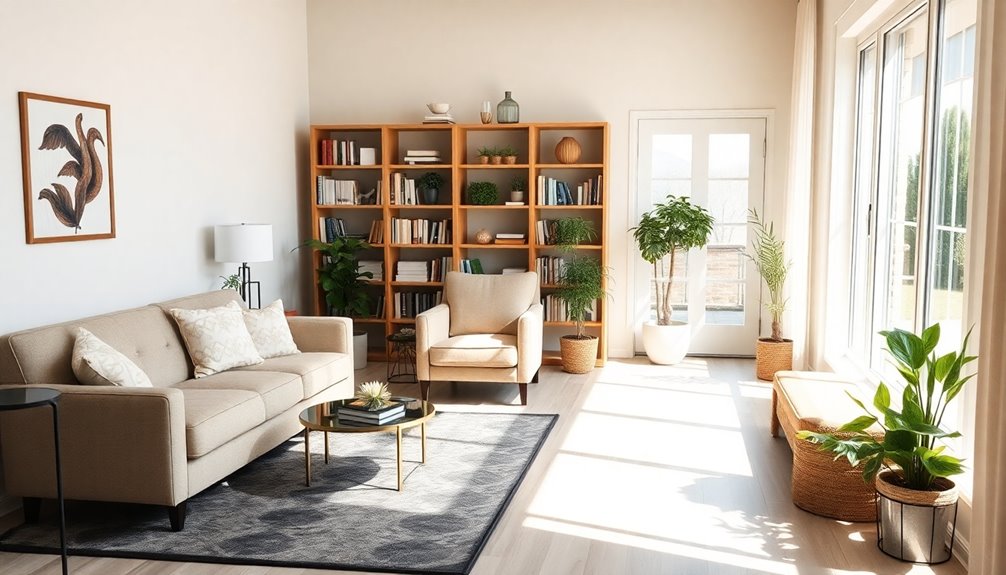
To guarantee seniors can move freely and safely throughout their homes, it's essential to focus on enhancing mobility.
Here are some practical tips to improve accessibility:
- Install grab bars in bathrooms and hallways for added support and confidence.
- Upgrade to lever-style door handles that require less strength, making it easier to open doors.
- Use non-slip mats in high-traffic areas to minimize trip hazards and provide a safer walking surface.
- Reduce thresholds between rooms to create smooth changes, especially for those using mobility aids.
Designing Elder-Friendly Staircases
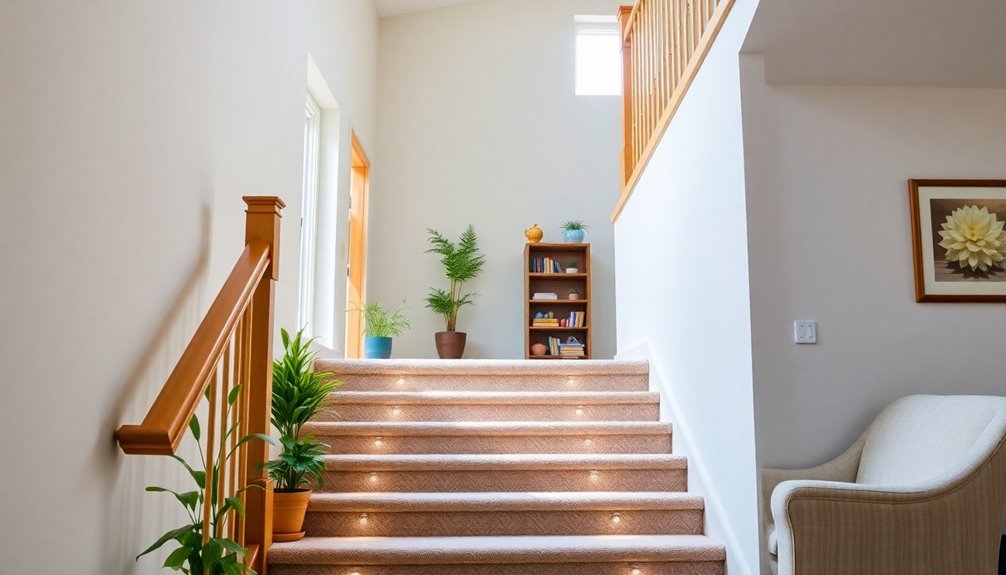
Staircases can pose substantial challenges for older adults, making thoughtful design essential for safety. To enhance safety, install handrails on both sides of the staircase, guaranteeing they're securely anchored and have a comfortable grip diameter. This provides maximum support while traversing stairs.
Proper lighting is vital too; use overhead fixtures to illuminate the entire staircase evenly, and consider motion-sensor lights for increased visibility when in use. Additionally, employing contrasting colors for handrails and steps can help seniors better navigate the stairs, reducing fall risks.
Don't forget regular maintenance checks to confirm treads are secure and free from hazards. These simple adjustments can greatly improve comfort and safety for older adults in your home.
Adapting Bathrooms for Increased Safety

To improve bathroom safety, consider installing grab bars in key areas like the shower and next to the toilet.
You should also opt for non-slip flooring to prevent dangerous slips, especially when the surfaces are wet.
These simple adjustments can make a big difference in creating a safer environment for older adults.
Install Grab Bars
While maneuvering a bathroom can be challenging, especially for the elderly, installing grab bars can make a significant difference in safety and confidence.
These essential additions help prevent accidents and create a comfortable environment. Here are some tips for effective grab bar installation:
- Choose strategic locations: Place grab bars next to toilets, inside showers, and near bathtubs.
- Vary heights: Install grab bars at different heights to accommodate individual needs.
- Secure properly: Verify grab bars are anchored to wall studs for maximum strength (at least 250 pounds).
- Pick styles that blend: Select styles and finishes that match your bathroom decor while maintaining functionality.
Non-Slip Flooring
How can you create a safer bathroom environment for seniors? One effective way is by installing non-slip flooring. Options like textured vinyl, rubber, or cork greatly reduce the risk of slips and falls—common accidents for the elderly. These surfaces not only enhance safety but also keep things comfortable.
Here's a quick comparison of non-slip flooring options:
| Type | Safety Feature | Aesthetic Appeal |
|---|---|---|
| Textured Vinyl | High | Modern Designs |
| Rubber | Very High | Various Colors |
| Cork | Moderate | Natural Look |
Choosing non-slip flooring guarantees hygiene and enhances the bathroom's overall look, making it an essential element for elderly comfort.
Optimizing Lighting for Aging Eyes
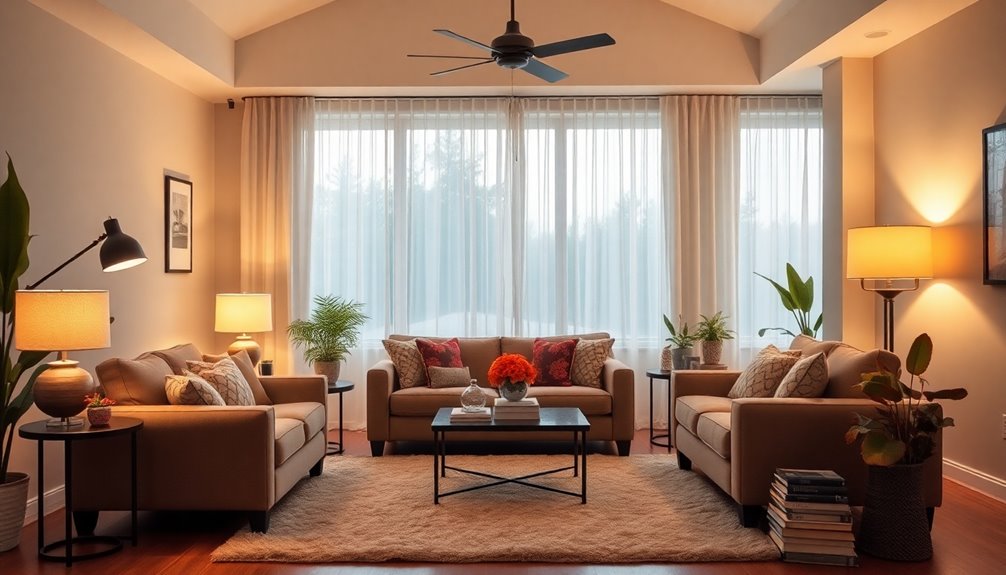
As you age, optimizing lighting in your home becomes vital for maintaining comfort and safety.
Aging eyes require more light, so enhancing visibility is important. Here are some tips to improve your lighting:
- Layer Your Lighting: Combine ambient, task, and accent lighting for a well-rounded approach.
- Maximize Natural Light: Use sheer window treatments to let in as much daylight as possible, boosting mood and well-being.
- Choose Warm Bulbs: Opt for warm light bulbs (2700K-3000K) to reduce glare and create a cozy atmosphere.
- Brighten High-Traffic Areas: Make certain spaces like hallways and kitchens are well-lit, aiming for 100-500 lux to prevent accidents and improve visibility.
Implementing Accessible Design Features
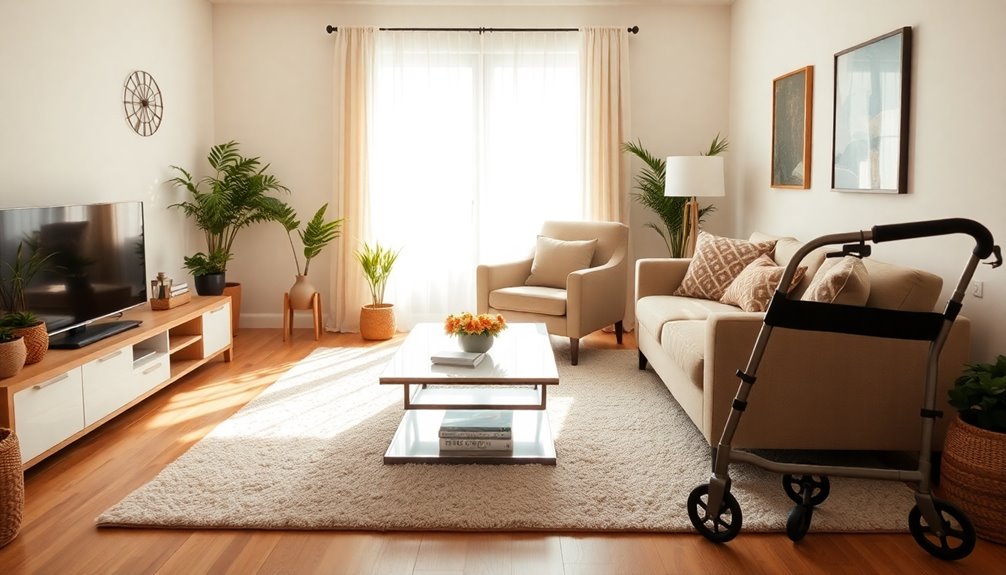
To create a comfortable and safe environment for elderly residents, implementing accessible design features is essential. Start by ensuring zero-threshold entries for smooth shifts, especially for those using mobility aids like walkers or wheelchairs. Wider doorways, at least 32 inches, and lever-style door handles make navigation easier. Install grab bars in bathrooms and hallways to provide crucial support and reduce fall risks. Additionally, opting for non-slip flooring materials like cork or rubber enhances safety in high-traffic areas.
| Feature | Benefit |
|---|---|
| Zero-threshold entry | Eliminates tripping hazards |
| Wider doorways | Accommodates mobility devices |
| Lever-style handles | Easier to operate |
| Grab bars | Supports safe navigation |
| Non-slip flooring | Reduces slip and fall incidents |
Personalizing Your Space for Comfort and Connection
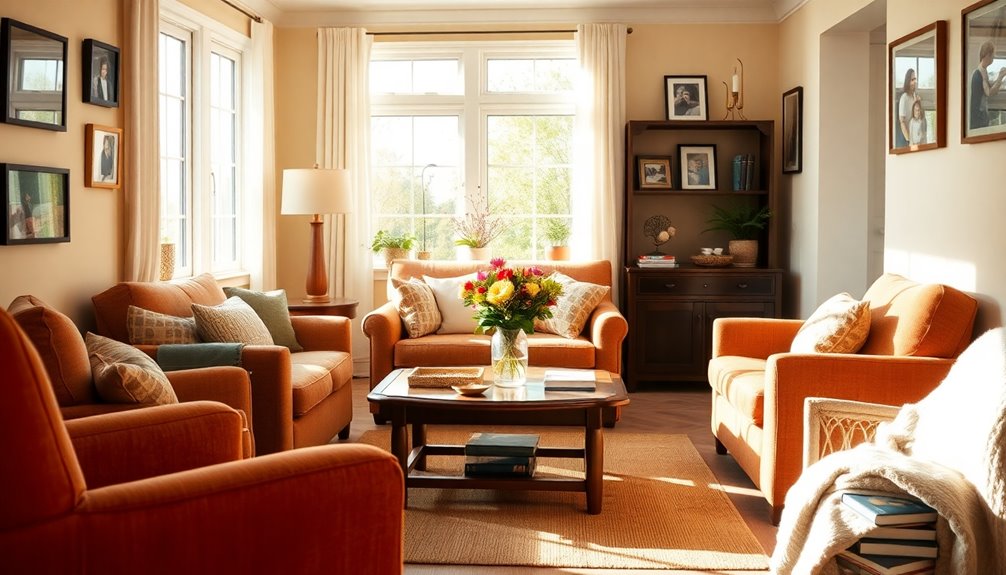
Creating a space that feels truly yours can greatly enhance comfort and connection in your home. Personalizing your living environment helps elevate your quality of life and well-being.
Here are some ideas to get you started:
- Display family photos: Showcasing cherished moments fosters a sense of belonging and connection.
- Incorporate meaningful artwork: Choose pieces that resonate with your personal history to evoke positive memories.
- Reflect your hobbies: Include decor elements that highlight your interests, creating an inviting atmosphere.
- Use a cozy color palette: Soft, warm tones promote relaxation, reducing anxiety and enhancing comfort.
Frequently Asked Questions
What Is the Ideal Living Arrangement for Older Adults?
The ideal living arrangement for older adults focuses on accessibility and safety.
You'll want a single-level home to minimize stairs, making it easier to move around. Open-concept spaces allow for better social interaction and movement.
Consider zero-threshold entries to eliminate tripping hazards, and use lever-style door handles for ease.
Finally, guarantee essential amenities like bathrooms and kitchens are on the main floor to enhance comfort and reduce the need for traversing stairs.
How to Design a House for Seniors?
Imagine stepping into a home where every corner welcomes you with ease.
To design a house for seniors, start by widening doorways and hallways, making navigation effortless. Install lever-style door handles that glide open with a gentle push.
Bright, glare-free lights illuminate pathways, while grab bars and non-slip mats create a safe haven in the bathroom.
Finally, consider relocating essential rooms to the main floor, ensuring comfort and independence in daily routines.
How to Design a Room for the Elderly?
When you design a room for the elderly, focus on creating an inviting and accessible space.
Start with an open layout to enhance mobility and reduce obstacles. Choose lever-style door handles for easier access, and guarantee clear pathways for walkers or wheelchairs.
Opt for non-slip flooring and low-pile rugs to prevent falls.
Finally, arrange furniture to promote social interaction, keeping seating areas welcoming and comfortable for both residents and visitors. This can be achieved by incorporating varying seating arrangements that encourage conversation, such as circular or semi-circular groupings. Additionally, consider using chic furniture layouts for aging that provide easy access and mobility for those with reduced physical capabilities. By thoughtfully selecting the right pieces, you can create an inviting atmosphere that enhances social connections and fosters a sense of community.
What Is the Most Desirable Home Design for Aging in Place?
The most desirable home design for aging in place focuses on accessibility and safety.
You'll want an open concept layout that allows easy movement without barriers. Consider zero-threshold entries to eliminate tripping hazards and lever-style door handles for easier operation.
In the kitchen, lower countertops and pull-out shelves will help you prepare meals comfortably.
Spa-inspired bathrooms with curbless walk-in showers and grab bars create a safe, luxurious space that promotes independence.
Conclusion
In revamping your living space, you're not just making changes; you're crafting an environment that nurtures comfort and safety for the elderly. By embracing universal design principles and focusing on accessibility, you're opening doors to independence and joy. Remember, a well-designed home isn't just a structure; it's a sanctuary that fosters connection and well-being. So, why settle for ordinary when you can transform your space into an extraordinary haven tailored for comfort?



